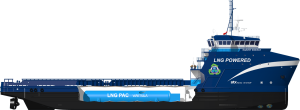NOIA Member Spotlight

Harvey Gulf International Marine, LLC, headquartered in New Orleans, Louisiana, is a marine transportation company that specializes in providing Offshore Supply and Multi-Purpose Support Vessels for deep water operations in the U.S. Gulf of Mexico. Harvey Gulf is founded on the premise that superior performance and safer operations provide its customers value and satisfaction. The company has been in operation since 1955. Harvey Gulf's fleet represents a state of the art collection of offshore support vessels ranging from 175ft to 340ft, encompassing supply vessels, fast supply vessels and construction vessels powered by the latest technology available with industry leading cargo handling capabilities. Harvey Gulf's focus on no harm to the environment is exemplified by bringing to the market the first in North America dual fueled LNG powered offshore supply vessels as well as the, first of its kind, LNG fueling facility in Port Fourchon, LA.

The first of six dual fuel offshore supply vessels, the M/V Harvey Energy, was delivered in 2015 and immediately went into service. The Harvey Energy built at GCSG in Gulfport, MS is based on the Vard Marine design and is 310x64x24.5ft powered by 3 Wartsila 6L34DF dual fuel gensets providing 7.5MW of power fueled by Wartsila’s LNGPac system. The Harvey Energy is US Flagged Subchapter I and L, SOLAS compliant and is classed by the ABS as +A1, OSV, +AMS, +DPS-2, +ACCU, UWILD, FFV-1, ENVIRO+, GP, GFS(Dual Fuel Diesel) E. With 5,150 tons of deadweight, the vessel is capable of carrying 253,000 USG of Fuel Oil, 18,000 Bbls of Liquid Mud, 1,600 Bbls of Methanol, 10,250ft3 of Dry Cement and 78,000 USG of LNG fuel.
The environmental benefits can be seen immediately with the use of LNG. The Harvey Energy when operating in gas mode will experience a 100% reduction in particulates, 100% reduction in SOx, 85% reduction in NOx and 25% reduction in CO2. This reduction in emissions will not only directly benefit the environment but also benefit the emission profiles of offshore rigs and installations when operating within their 25 mile exclusion zone. In addition to the environmental benefits associated with LNG as a fuel, Harvey Gulf has elected to have the vessels designed and built in accordance with ABS Enviro+ notation. The Enviro+ notation requires the vessel to be built in accordance with international environmental regulations such as MARPOL-International Convention for the Prevention of Pollution from Ships as well as the ABS Green Passport notation with respect to air and sea discharges. Harvey Gulf has also elected to use energy efficient lighting LED systems throughout the entire vessel reducing the lighting power consumption by approximately 35%.

To address the concerns related to LNG fueling systems, Harvey Gulf chose to utilize the industry proven LNGPac system developed by Wartsila. There are currently over 1300 Wartsila LNG powered dual fuel engines in service worldwide specifically with 123 in the offshore service industry. With over 5 million accumulated running hours for dual fuel engines, safety and reliability is quite evident.
As LNG does not burn or explode, to prevent against the potential for cryogenic liquid being released into the vessel, the entire LNG piping system is protected by a stainless steel double wall barrier with a ventilated annular space with gas detection. The LNG insulated storage tank is secured within a stainless steel barrier under vacuum. Vacuum pressure is maintained as a means to minimize evaporation losses. To mitigate the potential for hull damage during bunkering operations the hull is protected against LNG spills by means of a stainless steel drip tray and water spray curtain over the hull. Personnel involved in bunkering operations are protected by means of spray shields and protective clothing. Gas detection and fire suppression is also provided at the bunker station.

In the case of a LNG and/or vapor release, the LNG system is designed to immediately transcend over to diesel, shutdown the flow of natural gas and nitrogen purge the system. The LNG system utilizes inert nitrogen gas to avoid explosive mixtures of vapor and air in the system. In the case of vapor release or over pressurization the system utilizes a number of vent valves and pressure relief valves. The Harvey Energy is equipped with multiple vent relief lines. During bunker operations and normal vessel operations the areas in way of these vent reliefs are secured from personnel and sources of ignition.
In addition to the environmental benefits of LNG as a marine fuel and the proven safe technology of LNG, LNG can be upwards of 40% less cost per equivalent MMBTU less than diesel; Harvey Gulf expects to see a reduction in its operating costs with respect to fuel. The savings can be extended to our customers.
In addition to building and operating the first LNG powered vessels in North America, Harvey Gulf is also constructing and will operate the first LNG marine fueling facility in the United States, to be located at its vessel facility in Port Fourchon, LA. The fueling facility will be a vital addition to the growing national LNG supply infrastructure, supporting critical operations of the oil and gas industry’s offshore support vessel fleet operating on clean burning LNG. The tanks will be stainless steel Type ‘C’ pressure vessels with vacuum insulation and carbon steel exteriors. Each facility will be able to transfer 500 gallons of LNG per minute. Aside from the facilities primary role of supporting the Oil and Gas Industry, the facility will be capable of supporting over-the-road vehicles that operate on LNG.
For more information on Harvey Gulf International Marine visit www.harveygulf.com.

